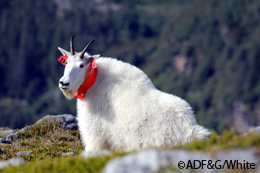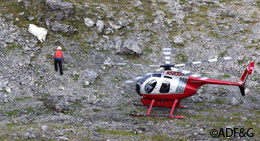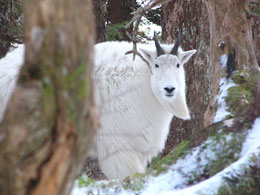Alaska Fish & Wildlife News
March 2012
Mountain Goats in Focus
Biologists Share Management and Research

Mountain goats are one of the least studied big game animals in North America. But that’s changing. Remarkable new tools and growing concerns for these agile, wooly beasts are providing unprecedented insights into their biology, behavior, needs and vulnerabilities.
Two dozen scientists gathered in Juneau in mid-February to share their experiences and knowledge studying and managing mountain goats. The vast majority of the world’s mountain goats live in Alaska and British Columbia, and Alaska Fish and Game biologists did most of the talking and listening. Biologists from Washington State, British Columbia and Alberta also shared their research and management experiences.
Biologist Doug Larsen helped organize the event. He said the gathering was the first of its kind in Alaska since 2000. “Before that, VHF collars represented the first big breakthrough in technology for goat research; since then, GPS collars have revolutionized data collection and our understanding of behavior,” he said. New tools for understanding genetics are also providing insights into evolution, colonization and movement between different goat populations.
The effect of helicopter over flights was a topic of considerable interest. Helicopter logging is widespread in British Columbia, as is helicopter-access skiing. Around Juneau, and in the Haines area in northern Southeast Alaska, helicopter skiing and sightseeing are growing industries. Understanding how goats use and depend on summer and winter habitat, and determining the degree to which helicopter activity and its associated disturbance is tolerable - or excessive - is important.
About 450 mountain goats are harvested each year in Alaska. How to best manage goat populations for hunting opportunities is important to biologists. A big part of that is how to effectively survey populations, so managers know how many goats live in various parts of the state and whether those numbers are stable, increasing or decreasing.
The status of goats varies tremendously. Cliff Rice from the Washington Department of Fish and Wildlife presented details about goats there and the history of goat hunting in the state. Goats are native to the Cascade Mountains and were introduced to the Olympic Mountains. In the 1960s hunters took up to 400 goats per year, mostly in the Cascades, and although it was not apparent at the time, this was an unsustainable amount of harvest. Harvests declined over the ensuing decades. Today the goat population in Washington state (about 2,800 goats) supports a harvest of only about 12 animals per year, and more than 12,000 hunters apply for the once in a lifetime opportunity to participate.
In contrast, Larry Van Daele talked about the growing population of goats on Kodiak Island, where about 160 goats are harvested each year. Goats from the Kenai Peninsula were introduced to Kodiak Island in the early 1950s. The US Fish and Wildlife Service released 18 goats in Hidden Basin on the north end of the island. In 1964 a survey showed 26 goats. In 1999 a survey showed 900, and in 2008 the population had grown to 2,200. They have considerably expanded their range and moved to the south end of the island as well. Surveys show that as the goats move into new areas there is a lot of twinning, a sign that habitat is good and animals are thriving. This is virgin habitat for the goats, and it’s productive. Of keen interest to Van Daele is determining the optimal number of goats for the habitat, and he suspects that’s well below 2,200.
About half of Kodiak Island is the Kodiak National Wildlife Refuge, managed by the USFWS. Ironically, the federal agency which introduced the animals now considers them to be an unwanted invasive species. The agency is concerned about the goats' impact on the habitat and native plants of special concern.
“As always with goats, access is the big issue for hunters and hunting is concentrated on areas with easiest access,” Van Daele said. Managers would like to see more hunting on the south end of the island where the population is growing, but it’s relatively difficult to access.
Goat populations tend to be distinct in different areas for two important reasons. The first, while mountain ranges are formidable barriers to many animals, they are home sweet home to goats, and forested valleys tend to be barriers. For example, goats on the Cleveland Peninsula in southern Southeast Alaska are fairly isolated and distinct from other mainland goats, and mountain goats on either side of Berners Bay are genetically distinct even though they are separated by just a few miles of flat coastal forelands/river valley habitat. And secondly, goats have fairly small home ranges as a general rule. They move between preferred summer and winter ranges and tend to favor the same areas year after year. That’s known as high site fidelity.

Biologist Steve Gordon with the British Columbia Ministry of Natural Resources reported that data collected from five goats equipped with GPS collars in the Atlin/Tulsequa area of BC provided 3,000 winter locations. He said 97 percent of the locations are within 200 meters of escape terrain, 45 to 60 degree slopes that are manageable for the agile goats but inaccessible to predators.
“Home ranges in BC tend to be small,” he said, “ranging from half a kilometer to just one and a half kilometers. GPS data indicates that some goats don’t move very far at all in winter – one animal moved just one-third of a kilometer, about the area of an office building.”
He said that underscores the importance of understanding how goats on winter range might be affected by heliskiing and other activities that could disrupt habitat use.
While most goats tend to favor small winter and summer home ranges, there are notable exceptions. Once in a while a goat – usually a two to four-year-old male – will travel considerable distances. One collared goat, a young billy on the Kenai Peninsula, moved 44 kilometers, crossing several valleys. In some cases this is related to dispersal – such as those Kodiak Island goats pioneering new areas. In other cases it’s related to reproduction.
“Observations indicate that mountain goats avoid mating with relatives,” said Canadian biologist Aaron Shafer. Shafer studies goats at Caw Ridge in Alberta, which he describes as, “An island patch of mountain goat habitat” in the eastern foothills of the Rockies, an area of about 28 square kilometers. Since 1988, almost every single animal in the population has been live trapped and marked, providing a unique opportunity to monitor reproduction, growth and behavior. The current population is about 120 animals, but 437 goats have been marked and studied over the past 24 years. There is a neighboring band of goats about 20 km distant, separated by a forested valley. During breeding season, a few of those goats visit Caw Ridge.
“Caw Ridge is not (genetically) distinct from the Rocky Mountain population, so just one or two males a year coming into the population can exert an influence,” Shafer said.
Those visiting or immigrating goats contribute genetic diversity to largely isolated populations. That’s important, because generally a few billy goats dominate the breeding in scattered subpopulations of goats, separated on ridges and mountains by valleys and fjords. On Caw Ridge, 50 percent of the herd’s offspring are sired by five males.
“The bigger older billies are the most successful reproducers – it’s unusual for males under six to be successful,” he said.
Older nannies are critical to the herd’s growth as well. “About 80 percent of the 9 to 11 year-old-females have a kid each year,” he said, “These are the primary contributors to the population. Longevity is key to reproductive success.” First time mothers – at four or five years old – tend to be somewhat less successful. The older nannies tend to have more kids that live past one year of age. The younger nannies also tend to skip a year and not get pregnant, a reproductive pause. Alaska researchers observed similar tendencies.
Wildlife managers who want to see a population grow do not want to see hunters take nannies, especially older nannies. In Alaska, and elsewhere, a “goat point system” is used in most areas to determine how many goats can be harvested annually. Nannies are worth two, billies are worth one, and a sustainable harvest might be assessed at six points per 100 goats surveyed in an area. That’s six billies or just three nannies harvested each year, and then the hunt is closed. The most effective tool for both providing more hunting opportunity and ensuring sustainable populations is reducing nanny harvest.

Biologists discussed a variety of ideas for managing hunts and hunters, balancing the desire to provide opportunity with the need to sustain goat populations. The same is true of industrial development, especially the use of helicopters in close proximity to critical goat habitat. In all cases, a better understanding of mountain goats is key.
Biologist Kevin White has been studying goats in Southeast Alaska since 2005, with ongoing projects along Lynn Canal, near Haines and Skagway, on the Cleveland Peninsula near Ketchikan, and on Baranof Island near Sitka. He said 227 mountain goats have been captured, 193 have been outfitted with GPS collars and the remainder with VHF collars. At this time, there are 87 animals marked in Southeast (Lynn Canal = 33, Haines/Skagway = 26, Baranof Island= 18, Cleveland Peninsula = 10).
At the time of capture researchers collect blood (tested for disease, trace minerals, stable isotope, genetic analyses), hair (for isotope, genetics), and pellets (for diet). They also determine sex, lactation status, age (via horn annuli), body mass, rump fat thickness (only on a subset of animals), and various morphological measurements.
White and his colleagues have found that goats are gaining about a half-pound of body mass a day in late summer - weight for a mature male can go from 260 to 300 pounds between Aug.1 and Oct. 15. A four-year-old female goat is essentially full size at 180 pounds, a six-year-old male is full size at about 280 pounds. White said the largest male weighed was 385 pounds and the largest female was 260, both captured in Haines.
White touched upon some of the mortality issues for goats. “As a general rule, fall body condition and winter food supply determines winter survival,” he said. “There is a spike in mortality in October for both sexes, which coincides with first snows. This is possibly due to early avalanches, and the risk of traveling between the summer and winter habitat through unfamiliar terrain which might include bear habitat. There is a second more pronounced spike in late winter, February through May.”
He said mortality tends to be higher after a hotter summer, and this may be related to forage. The most nutritious forage occurs at the edge of snow patches, the early growth sprouting as snow melts, and a cooler summer protracts and extends the season for this growth. It’s also possible heat stress could be a factor as well – goats are best equipped for winter, not summer.
He mentioned the causes of death he’s observed for goats in Southeast, including malnutrition, bear predation (difficult to determine, since scavenging is also common), avalanches (this is the easiest to determine, given the evidence at the scene), falling, human hunters and wolf predation. While wolves are also scavengers, in four cases wolf predation was not difficult to determine - the data from a collared wolf in a pack overlays the same date and time as a collared goat’s (last) location. In one case the wolf stayed at the location for three days, and later, a GPS collared wolverine scavenged the remains of the goat.
Technology such as this can provide amazing insight into the largely inaccessible and often snow-bound world of mountain goats. While not comprehensive, this overview offers a look at some of the issues and challenges wildlife managers are facing, and some insights into mountain goat research and management.
Larsen said it’s valuable for wildlife biologists to gather ever few years to evaluate new information and new findings, especially as they inform the direction of future management and conservation.
“I think it’s very important that we periodically bring experts together to share the state of our knowledge, especially when new information has been gained that can inform new and improved management directions,” he said.
Riley Woodford is the editor of Alaska Fish and Wildlife News. He observes goats year-round on the slopes of Mt. Juneau.
Subscribe to be notified about new issues
Receive a monthly notice about new issues and articles.
